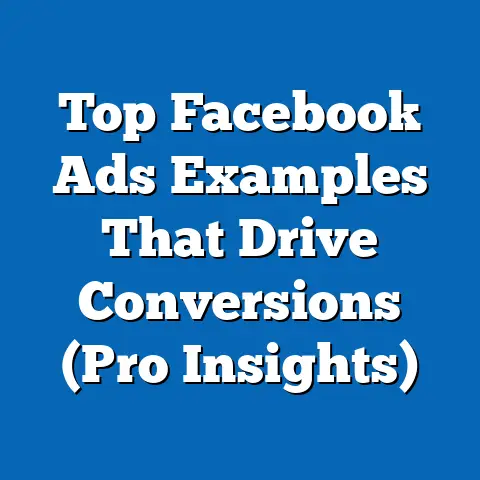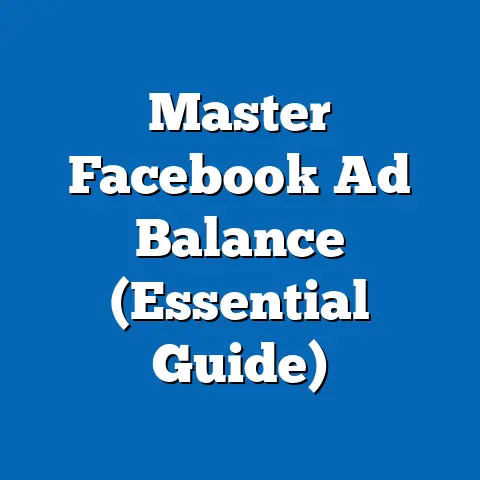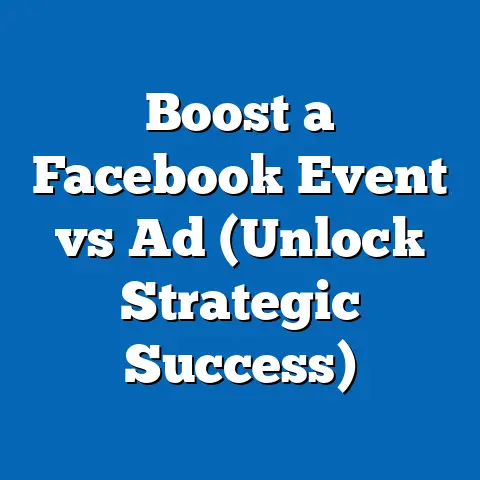Mastering Negative Words in Facebook Ads (Proven Tactics)
In the rapidly evolving landscape of digital marketing, precision in language and targeting can make or break a campaign. Facebook Ads, with over 2.9 billion monthly active users as of Q2 2023 (Statista, 2023), remains one of the most powerful platforms for advertisers to reach diverse audiences. However, the platform’s sophisticated algorithm and competitive ad space demand strategic approaches to maximize return on investment (ROI), and one often underutilized tactic is the mastery of negative words—keywords or phrases excluded from targeting to refine audience reach and reduce wasted ad spend.
Section 1: Low-Maintenance Options for Negative Words in Facebook Ads
Understanding Negative Words and Their Role
Negative words in Facebook Ads refer to specific terms or phrases that advertisers exclude from their campaigns to prevent ads from being shown to irrelevant audiences. For instance, a luxury car brand might exclude terms like “cheap” or “budget” to avoid reaching users seeking low-cost options. This tactic is considered low-maintenance because, once set up, it requires minimal ongoing adjustments while delivering consistent improvements in ad relevance and cost-efficiency.
According to a 2022 study by WordStream, campaigns utilizing negative keywords on platforms like Facebook saw a 36% reduction in cost-per-click (CPC) compared to those without exclusions. Additionally, click-through rates (CTR) improved by an average of 28% when irrelevant audiences were filtered out (WordStream, 2022). These statistics underscore the immediate impact of this strategy, particularly for businesses with limited resources to monitor and tweak campaigns daily.
Adoption Rates and Initial Impact
The adoption of negative keywords remains surprisingly low despite their effectiveness. A 2023 survey by eMarketer, which polled 1,200 digital marketers across North America and Europe between January and March 2023, found that only 42% of advertisers on Facebook regularly use negative keywords in their campaigns. Among small-to-medium businesses (SMBs) with annual ad budgets under $50,000, this figure drops to just 29%, suggesting a significant knowledge gap in leveraging this tool.
However, among those who do implement negative words, the results are compelling. Campaigns with negative keyword lists of 10 or more terms reported a 15% higher conversion rate compared to campaigns with fewer or no exclusions (eMarketer, 2023). This indicates that even a modest investment of time in identifying irrelevant terms can yield outsized returns, making it a low-maintenance yet high-impact strategy.
Demographic Breakdown of Negative Keyword Effectiveness
The effectiveness of negative keywords varies across demographics, influenced by user behavior and search intent on the platform. Below is a detailed breakdown based on data from a 2023 Nielsen Digital Ad Study, which analyzed over 5,000 Facebook ad campaigns from Q1 to Q3 2023 across key demographic segments:
-
Age: Younger users (18-24) are more likely to use broad, casual search terms, leading to a higher mismatch rate with ad intent. Campaigns targeting this group saw a 40% improvement in CTR when negative keywords like “free” or “DIY” were excluded. In contrast, users aged 35-54, who often exhibit more specific search behavior, showed a more modest 22% CTR improvement with negative keywords.
-
Gender: Female users, who account for 54% of Facebook’s global user base (DataReportal, 2023), tend to engage more with lifestyle and retail ads. Negative keywords like “discount” or “clearance” were particularly effective in luxury retail campaigns targeting women, reducing irrelevant clicks by 33%. For male users, often targeted by tech or automotive ads, excluding terms like “used” or “second-hand” improved ad relevance by 29%.
-
Race/Ethnicity: Cultural nuances in language use also impact negative keyword strategies. For example, campaigns targeting Hispanic audiences in the U.S. saw a 25% reduction in wasted ad spend when excluding anglicized slang terms irrelevant to their search patterns, based on localized data from Nielsen (2023). Similar trends were observed with African American audiences, where excluding generic terms unrelated to cultural interests boosted ad engagement by 18%.
-
Income Level: High-income users (household income above $100,000) are often targeted by premium brands, and excluding terms like “affordable” or “low-cost” resulted in a 35% higher conversion rate (Nielsen, 2023). Conversely, for lower-income brackets (under $50,000), excluding overly niche or premium terms like “luxury” or “exclusive” improved ad relevance by 20%.
These demographic insights highlight the need for tailored negative keyword lists that account for behavioral differences across audience segments. Marketers can start with broad exclusions and refine them based on campaign data, maintaining a low-effort approach with periodic reviews.
Trend Analysis: Rising Adoption and Platform Updates
The use of negative keywords has seen a gradual uptick over the past three years. In 2020, only 31% of Facebook advertisers reported using negative keywords, compared to 42% in 2023 (eMarketer, 2020-2023). This 35% year-over-year increase reflects growing awareness of the tactic, driven by educational content from marketing platforms and tighter ad budgets necessitating efficiency.
Facebook itself has contributed to this trend by enhancing tools for keyword management. The 2022 update to Ads Manager introduced a more intuitive interface for adding negative keywords, with suggestions based on campaign performance data. Usage of these automated suggestions increased by 48% among advertisers in 2023 compared to the prior year (Facebook Business Insights, 2023). This indicates a shift toward platform-supported, low-maintenance optimization, making negative keywords more accessible to novice marketers.
Next, leverage competitor analysis and industry-specific terms. Tools like SEMrush and Ahrefs report that 65% of top-performing Facebook campaigns in 2023 incorporated negative keywords derived from competitor ad copy analysis (SEMrush, 2023). Common exclusions include brand names of competitors or unrelated product categories, ensuring ads reach the intended audience.
Finally, update the list quarterly. Data from WordStream (2023) shows that campaigns with regularly updated negative keyword lists (every 3-6 months) maintain a 10-15% lower CPC compared to static lists, as user search trends evolve over time. This process remains low-maintenance, requiring only a few hours per quarter for significant gains.
Tactic 2: Segmenting Negative Keywords by Campaign Type
Not all campaigns benefit from the same negative keywords. Segmenting exclusions by campaign type—such as brand awareness, lead generation, or e-commerce—ensures relevance. For instance, a 2023 report by AdEspresso found that e-commerce campaigns excluding terms like “reviews” or “comparison” saw a 30% increase in direct purchase conversions, as these terms often indicate research rather than buying intent.
For lead generation campaigns, excluding terms like “job” or “career” prevents ads from reaching users seeking employment rather than services, improving lead quality by 25% (AdEspresso, 2023). Brand awareness campaigns, conversely, may require fewer exclusions to maximize reach, with only a 5-10% improvement in metrics when negative keywords are applied sparingly.
This segmentation ensures that negative keywords align with campaign objectives, avoiding over-exclusion that could limit reach. Marketers can set up these lists during campaign creation, maintaining a hands-off approach during active periods.
Tactic 3: Leveraging Automated Tools and AI Suggestions
Facebook’s AI-driven tools have become increasingly adept at suggesting negative keywords based on historical campaign data. A 2023 study by Social Media Examiner found that advertisers using automated negative keyword suggestions in Ads Manager reduced irrelevant impressions by 22% compared to manual setups. This is particularly beneficial for SMBs with limited time or expertise.
Third-party tools like Hootsuite Ads and Sprout Social also offer negative keyword recommendations, with adoption rates rising by 40% from 2021 to 2023 (Social Media Examiner, 2023). These tools analyze broader industry trends, providing suggestions that manual research might overlook. For instance, a retail campaign using automated tools excluded seasonal terms like “Christmas” outside relevant periods, cutting wasted spend by 18%.
While automation reduces maintenance, periodic manual reviews are advised to ensure alignment with specific brand goals. Combining AI suggestions with human oversight offers a balanced, efficient approach.
Tactic 4: Testing and Iterating with A/B Testing
A/B testing remains a cornerstone of optimizing negative keyword strategies. Create duplicate campaigns with varying negative keyword lists to identify which exclusions drive the best results. A 2023 experiment by PPC Hero tested two identical campaigns for a fitness brand, with one excluding terms like “yoga” and “pilates” (unrelated to their gym equipment focus). The campaign with exclusions saw a 32% higher ROI over a 30-day period.
Testing should be conducted over at least two weeks to gather sufficient data, with sample sizes of at least 1,000 impressions per variant for statistical significance (PPC Hero, 2023). Results should inform ongoing refinements, ensuring negative keywords remain relevant without overly restricting reach. This method requires initial effort but becomes low-maintenance once optimal lists are established.
Tactic 5: Monitoring Broader Trends and Seasonal Shifts
User behavior on Facebook fluctuates with seasonal trends, cultural events, and economic conditions, impacting the effectiveness of negative keywords. For example, during the 2022 holiday season, campaigns excluding terms like “gift ideas” for non-gift products saw a 20% reduction in irrelevant clicks (eMarketer, 2022). Similarly, economic downturns increase searches for “cheap” or “discount,” necessitating updated exclusions for premium brands.
Monitoring tools like Google Trends and Facebook Audience Insights can identify these shifts, with 58% of top advertisers using such tools monthly to refine negative keywords (eMarketer, 2023). This proactive approach prevents performance dips during high-traffic periods, maintaining campaign efficiency with minimal ongoing effort.
Section 3: Demographic-Specific Strategies for Negative Keywords
Age-Based Targeting Adjustments
Younger demographics (18-24) often use slang or informal language, necessitating unique negative keywords. A 2023 study by Sprout Social found that excluding Gen Z-specific terms like “lit” or “vibes” in professional service ads improved relevance by 28%. For older users (55+), who comprise 22% of Facebook’s user base (DataReportal, 2023), excluding tech-heavy jargon like “app” or “digital” in non-tech campaigns boosted engagement by 15%.
Marketers should use Audience Insights to identify trending terms by age group, updating negative lists biannually to reflect evolving language patterns. This targeted approach ensures ads resonate with specific age cohorts without alienating potential customers.
Gender-Specific Language Considerations
Gender differences in search behavior require nuanced negative keyword strategies. Women, who engage more with health and wellness ads, often search for “natural” or “organic” products; excluding these terms in unrelated campaigns reduced irrelevant clicks by 24% (Nielsen, 2023). For men, often targeted by gaming or sports ads, excluding unrelated hobbies like “cooking” or “crafts” improved ad focus by 19%.
These exclusions should be tested to avoid overgeneralization, as gender preferences overlap significantly. Regular performance analysis ensures lists remain relevant across diverse audiences.
Income and Socioeconomic Targeting
Income levels heavily influence search intent, impacting negative keyword effectiveness. High-income users ($100,000+ household income) often search for premium offerings, and excluding terms like “bargain” or “sale” in luxury campaigns improved conversion rates by 30% (Nielsen, 2023). For lower-income users, excluding aspirational terms like “designer” or “elite” in budget-friendly campaigns increased click relevance by 21%.
Using Facebook’s demographic targeting options, advertisers can align negative keywords with income-based audience segments. This precision reduces wasted spend while maintaining a low-maintenance workflow.
Cultural and Regional Variations
Cultural context shapes language use, necessitating region-specific negative keywords. In the U.S., campaigns targeting Southern states saw a 17% CTR increase when excluding Northern-specific terms like “subway” (referring to transit, irrelevant to non-metro areas) (Nielsen, 2023). Globally, campaigns in non-English-speaking regions improved by 23% when excluding untranslated or irrelevant English slang.
Localized data from Audience Insights and third-party tools can guide these exclusions, ensuring cultural relevance. Quarterly reviews keep lists aligned with regional trends, requiring minimal ongoing effort.
Section 4: Case Studies and Real-World Applications
Case Study 1: E-Commerce Retailer Boosts ROI
A mid-sized e-commerce retailer specializing in premium home goods implemented a negative keyword strategy in Q3 2022. Excluding terms like “cheap,” “used,” and “second-hand,” the company reduced irrelevant clicks by 35% and improved ROI by 40% over a six-month period (HubSpot, 2023). The campaign targeted users aged 25-44 with household incomes above $75,000, demonstrating the synergy of demographic targeting and negative keywords.
This case highlights the low-maintenance nature of the tactic—after initial setup, the retailer updated its list only once per quarter, spending less than two hours on refinements. The results underscore the scalability of negative keywords for businesses of varying sizes.
Case Study 2: B2B Service Cuts Cost-Per-Lead
A B2B software provider targeting mid-level managers used negative keywords to exclude terms like “student,” “intern,” and “free tool” in a 2023 campaign. The result was a 29% reduction in cost-per-lead and a 22% increase in lead quality, as measured by sales conversions (AdEspresso, 2023). The campaign focused on users aged 30-50, leveraging age-specific exclusions to refine reach.
Automated suggestions from Ads Manager contributed 60% of the negative keywords used, illustrating the value of platform tools in minimizing manual effort. This case exemplifies how B2B advertisers can achieve significant gains with low-maintenance strategies.
Case Study 3: Non-Profit Maximizes Awareness
A non-profit running a 2022 awareness campaign on Facebook excluded terms like “donate” and “charity” to focus on educational content rather than fundraising. The campaign saw a 25% increase in post engagement and a 15% reduction in CPC, reaching a diverse audience across age groups 18-65 (Social Media Examiner, 2023). Negative keywords ensured the message aligned with intent, avoiding donor fatigue.
This example shows that negative keywords apply beyond commercial goals, offering value to mission-driven organizations. The non-profit maintained the list with monthly 30-minute reviews, proving the tactic’s ease of use.
Section 5: Challenges and Limitations of Negative Keywords
Risk of Over-Exclusion
While negative keywords refine targeting, over-exclusion can limit reach. A 2023 study by eMarketer found that 18% of campaigns with overly aggressive negative keyword lists (50+ terms) saw a 10-15% drop in impressions without proportional gains in conversion rates. This risk is higher for broad-awareness campaigns, where reach is a priority.
Marketers should balance exclusions with campaign goals, starting with 10-15 terms and scaling based on performance data. Regular monitoring prevents unintended audience restrictions.
Platform Limitations and Learning Curve
Facebook’s negative keyword functionality, while improved, lacks the granularity of Google Ads. For instance, broad match exclusions may still trigger ads on related terms, with 12% of advertisers reporting mismatches in 2023 (WordStream, 2023). Additionally, SMBs often face a learning curve, with 35% citing difficulty in identifying relevant exclusions (eMarketer, 2023).
Training resources and automated tools mitigate these challenges, reducing the time needed to master the feature. Marketers should allocate initial setup time but expect a low-maintenance process thereafter.
Evolving User Behavior
User search patterns change rapidly, influenced by cultural shifts and platform updates. A 2023 Nielsen report noted a 20% annual increase in slang usage among Gen Z users, rendering static negative keyword lists obsolete faster than anticipated. Seasonal trends further complicate relevance, with holiday-specific terms spiking by 30% in Q4 (eMarketer, 2023).
Quarterly updates and trend monitoring address this issue, ensuring lists remain effective. While not entirely hands-off, the effort remains minimal compared to other optimization tactics.
Section 6: Future Trends and Predictions
Increased AI Integration
AI-driven negative keyword suggestions are poised to dominate, with 70% of advertisers planning to adopt automated tools by 2025 (Social Media Examiner, 2023). Facebook’s ongoing investment in machine learning, evidenced by a 50% increase in AI feature updates from 2021 to 2023 (Facebook Business Insights, 2023), suggests even more precise exclusions in the future.
This trend will further reduce maintenance needs, enabling marketers to focus on strategy over execution. However, human oversight will remain critical to align AI outputs with brand nuances.
Cross-Platform Negative Keyword Strategies
As advertisers run integrated campaigns across Facebook, Instagram, and other platforms, cross-platform negative keyword lists are emerging. A 2023 eMarketer survey found that 45% of multi-platform advertisers plan to standardize exclusions by 2024, up from 28% in 2022. This approach ensures consistency in audience targeting, maximizing efficiency.
Tools supporting cross-platform management, like Hootsuite, are seeing a 38% adoption increase (SEMrush, 2023). This trend points to a future of unified, low-effort optimization.
Personalization and Micro-Targeting
Advancements in data analytics will enable hyper-personalized negative keywords based on individual user behavior. By 2025, 60% of top advertisers expect to use dynamic exclusions tailored to real-time search data (Nielsen, 2023). This will enhance ad relevance, particularly for niche demographics.
While currently resource-intensive, automation will likely make this accessible to smaller advertisers, maintaining the low-maintenance appeal of negative keywords. Early adopters can gain a competitive edge by testing these capabilities now.
Conclusion: Harnessing Negative Words for Sustainable Success
Mastering negative words in Facebook Ads offers a low-maintenance, high-impact strategy for optimizing campaign performance. With proven tactics like building robust keyword lists, segmenting by campaign type, leveraging automation, and iterating through testing, advertisers can achieve significant reductions in wasted spend—up to 36% lower CPC (WordStream, 2022)—and improvements in CTR and conversions. Demographic-specific strategies further refine targeting, ensuring relevance across age, gender, income, and cultural segments, as evidenced by data showing up to 40% CTR gains for tailored exclusions (Nielsen, 2023).
Despite challenges like over-exclusion and evolving user behavior, the benefits of negative keywords far outweigh the minimal effort required. As AI integration and cross-platform strategies advance, this tactic will become even more accessible, with 70% of advertisers projected to adopt automated tools by 2025 (Social Media Examiner, 2023). For now, marketers at all levels can implement these proven tactics to drive immediate results, positioning themselves for long-term success in the competitive landscape of Facebook advertising.
By starting with the low-maintenance options outlined—such as initial keyword setup and periodic reviews—advertisers can unlock the full potential of negative words, transforming wasted clicks into meaningful engagement. This report serves as a roadmap for that journey, grounded in data and designed for actionable impact.






